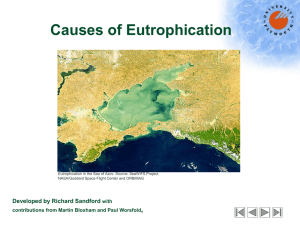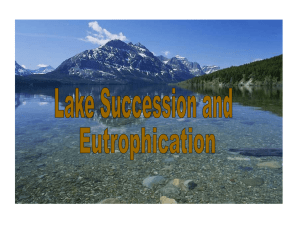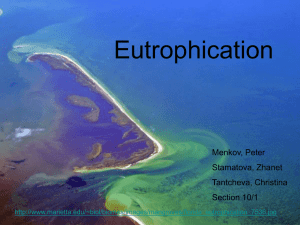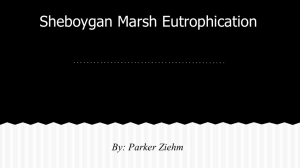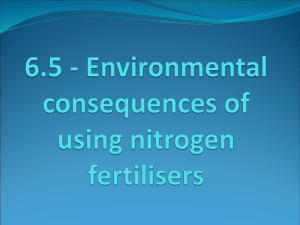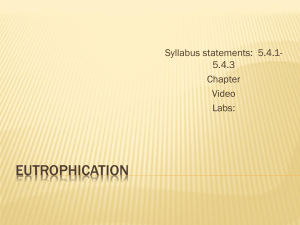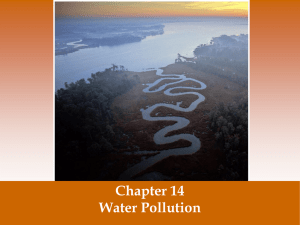Student`s Name: Minsung Kim
advertisement
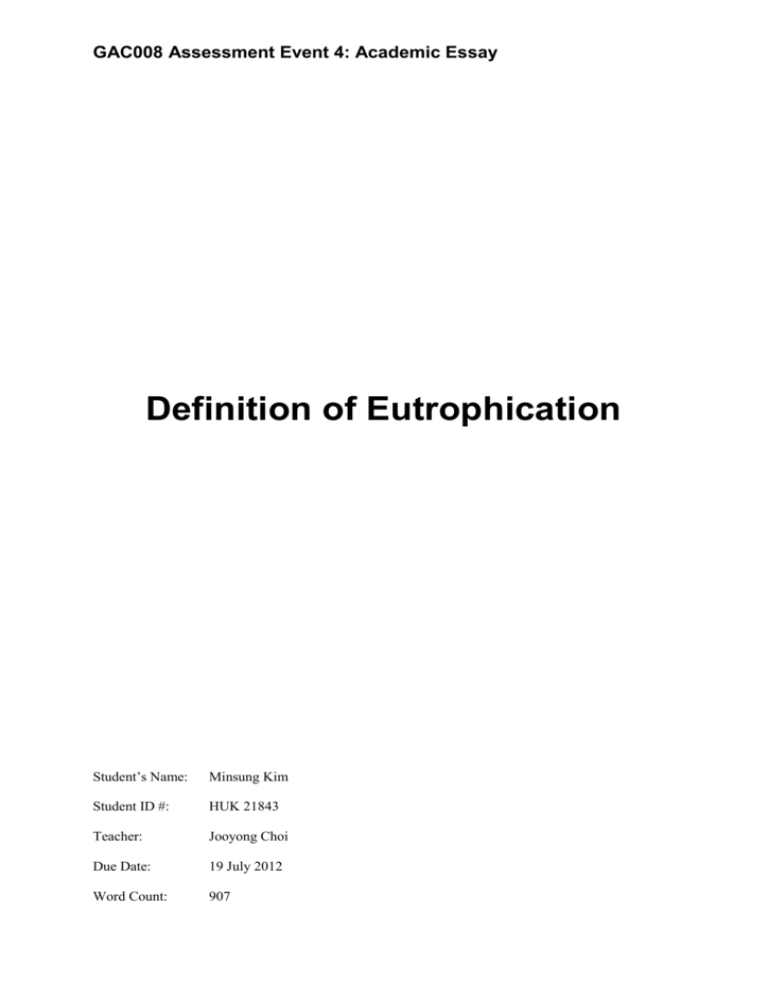
GAC008 Assessment Event 4: Academic Essay Definition of Eutrophication Student’s Name: Minsung Kim Student ID #: HUK 21843 Teacher: Jooyong Choi Due Date: 19 July 2012 Word Count: 907 GAC008 AE#4 Minsung Kim HUK 21843 Topic: what is meant by Eutrophication? Explain with reference to the severity of the problem in your own country. According to the Oxford English Dictionaries, the meaning of eutrophication is “over nutrients in a lake or any body of water” (Oxford). In other words, there is too much organic matter that is harmful to the water. However, Cloern mentions that one of the reasons for eutrophication is global warming, which means the earth’s temperature is getting higher than usual. He also mentions that eutrophication is hard to define definition as it has changed a lot from the past to the present. Moreover, it is due to human behavior such as improper disposing of human excrements in lakes, rivers, ponds or seas. Eutrophication usually happens where people are crowded. In order to define the eutrophication phenomenon, its causes, effects and outcomes, especially in South of Korea is needed. Furthermore, the cause, effect and outcomes related to define the meaning. Firstly, ideas of eutrophication can be largely divided into two types: green tide and red bloom. To define the green tide, it appears in ponds, lakes or rivers and not in the sea with green bloom. The green bloom is usually called as green tide. The reason of being bloomed is plenty of nutrients that are sewage and block sunlight. The sewage provides Nitrogen (N) and Phosphorus (P) molecules, which are produced while sewage is dissolving in the body of water. In addition, blocked sunlight is another cause of eutrophication. The reason is that when the sunlight is blocked, water cannot have enough access to oxygen. Actually, it occurs when water interacts with sunlight and water because molecules in the water have hydrogen and oxygen. The reason is that sunlight divides the molecules into two: hydrogen and oxygen. This oxygen is given to the organic creatures and plants for their living. Secondly, red tide appears around coastline but there is a huge different between green and red tide, which is green tide provided by sewages and wastewater. However, the red tide is provided by plankton which dissolves in the body of sea water. Emphasizing this idea, the water cannot recycle properly because of sewage in seabed and dead fish bodies makes eutrophication worse. Moreover, as time goes by, the temperature of seawater increases by global warming, and the movements of organic matters are produced faster than usual and it leads to accelerated eutrophication. 19/07/2012 page 1 GAC008 AE#4 Minsung Kim HUK 21843 The cause of eutrophication can be divided into various reasons, but the main cause is global warming, which concerns the entire world. If the temperature rises, the nutrients in a body of seawater will increase at the same time. As soon as this occurs, oxygen in the sea water disappears because of the over nutrients. Moreover, the increasing organic matter cause marine animals to die and it becomes a part of the soil. Furthermore, the organic matter mixes with other soils, which is in the deep seabed. As time goes by, the eutrophication becomes worse. Moreover, there are various negative impacts that can be largely classified into three: human health, aesthetic, and economic impacts. Cyan toxins cause human death, and diseases such as skin problems and cancer. Secondly, according to research on eutrophication, aesthetics “ unsightly scums”(Mbzia). Lastly, the economy can be impacted directly or indirectly. To be more specific, there are three economic impacts of recycling water, running out stocks, and disinfection cost. These are giving direct impacts to the economic condition, however, to prevent not have bad economic impacts, saving resources are required. Eutrophication is a big issue in the Republic of Korea, especially in Gunsan, According to Gunsan researchers, the Gunsan coastline is the most polluted place in Korea because of eutrophication (Kim Jong-Gu and Tea-Ju Jeong 957). The eutrophication was accelerated by human behavior by exposing sewages and wastewater, released by residential and industrial areas. Furthermore, they are trying to find the way to make good water quality. According to Gunsan, they research water in lakes after that they defined as“ the average concentrations of dissolved inorganic nitrogen and dissolved inorganic phosphorus at surface waters were exceeding second grade of water quality criteria respectively” (Journal of Environment Science 957). Which means that Gunsan found their lakes getting water bloomed. To not be water bloomed beta base have to be demanded to recover the water blooms. To compare with Gunsan, Chung one has similarities with Gunsan, which is caused by sewage and wastewater. According to Seo Jung-Kwan, plants that grow from sewag and wastewater can grow 1.8 times higher then other natural plants in lakes or rivers. Moreover, the second difference between Chang one and Gunsan is Accelerated Graph Port (AGP ). Chung one has slightly above point 19/07/2012 page 2 GAC008 AE#4 Minsung Kim HUK 21843 compared to Gunsan and the Byungsung Stream area which means that Chung one is more polluted than other regions. In sum, eutrophication happens all over the world and it is one of the most concerning problems. In order to prevent the green and red bloom, the South Korean government and society need to care and think about environment by saving and reusing energy and participating many institutions and activities, which is related to environmental movement organizations. For examples: maintain lakes or rivers nearby people and supporting development and concentrating in region`s recovery systems by supported from the government in South of Korea. As supporting by society organization, the eutrophication might be helpful to be recovered. References Andersen, Jesper H. et al. “Horizons.” Journal of Plankton Research. 28.7 (2006): 621-628. 6 July 2012. 19/07/2012 page 3 GAC008 AE#4 Minsung Kim HUK 21843 “About Eutrophication.” World Resources Institution.n.d. Web. 19 July 2012. Cloern, James E. “Eutrophication.” The Encyclopedia of Earth. The Encyclopedia of Earth, 18 Dec. 2007. 6 July 2012. “Eutrophication degrades water quality.” IAGLR. IAGLR, 6 Apr. 2011. Web. 6 July 2012. Gilluly, Richard H. “Eutrophication Speeded by Man.” Science News. 98.1 (1970): 17-19. Jstor. Web. 19 July 2012. Hasset, R. Patrick. “Effect of red tide.” Journal of Plankton Research. 25.2 (2003): 185-192. Oxford. Web. 14 July 2012. Oxford. “ Eutrophication.” Oxford Dictionaries. 2012. Web. 11 July 2012. “ Red tide is harmful bloom.” NOAA. NOAA, 11 July 2012. Web. 14 July 2012. Seo Jung-Kwan. et.al “Effect of the Sewage and Wastewater Plant Effluent on the Algal Growth Potential in the Nakdong River Basin.” An International Journal of Algal Research. 18.2 (2003):157-167. ALGAE. Web. 19 July 2012. Kim Jong-Gu and Tea-Ju Jeong. “A study on Eutrophication control.” Journal of Environment Science. 12.9 (2003): 957-966. Journal of Environment Science. Web. 6 July 2012. Msbiza, Noloyiso. “Eutrophication.” National Eutrophication Monitoring Programme Design. n.d. Web. 19 July 2012. 19/07/2012 page 4


